The classic "wave" pattern is universal in its application. It is used for knitting the entire product, and for the design of the edges. In addition, it combines well with other ornaments. Given its simplicity and effectiveness, to master the knitting of the "wave" pattern does not interfere with even novice knitters.
Openwork fashion
To create the right "wave", it is necessary to observe a simple rule: in each row, the number of Nakida must correspond to the number of loops associated together. For example, on the submitted scheme in the fourth row, it is proposed to check six nakids and tie together six pairs of loops.
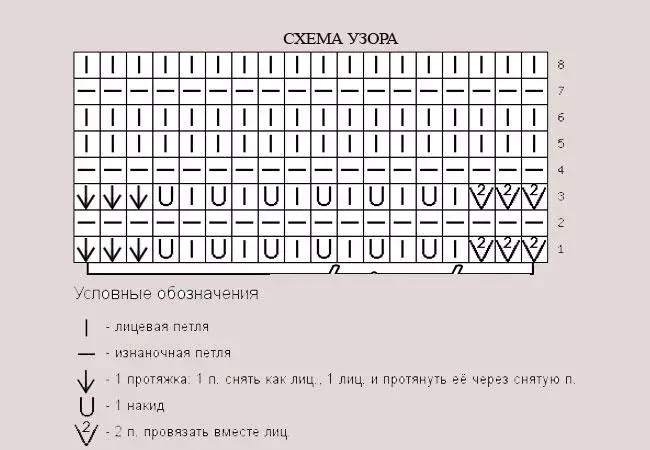
Rapport classic openwork wave - 4 rows. The first and the third knit with hinges, the second - facial. The fourth creates a wavy pattern.
To do this, at the beginning of a number of two hinges are associated with the facial (three pairs), then the nakida and facial loops are alternate (6 and 5, respectively), then another three more pairs of loops are pronounced.
A classic "wave" can be modified at the request of the author: to increase the number of rope rows, increase the number of connected loops or alternate the pattern with others.
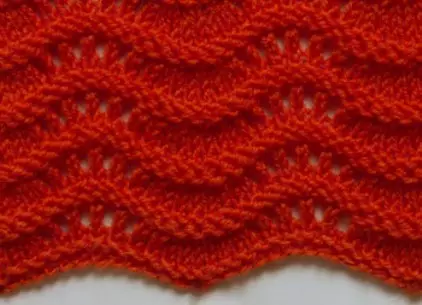
Relief method
The embossed "wave" is also considered an openwork pattern, but products in such a technique are slightly tight and warmer. Waves are obtained by volumetric, only sections between them remain openwork. Knit the embossed "wave" is more difficult, the rapport of this pattern is 14 rows.
To begin with, in the first row, you need to penetrate the front two loops together. Then three facial, nakid, one more facial, again nakid and three facial. At the end you need to check the front two loops together, but already for the front walls. In even rows of CO 2, 10, as well as in 11 and 13, all hinges knitted by purl. According to the description of the first row, the remaining odd ranks. Facial loops should be knitting 12 and 14 row.
Article on the topic: How to make a wooden shower at the cottage?
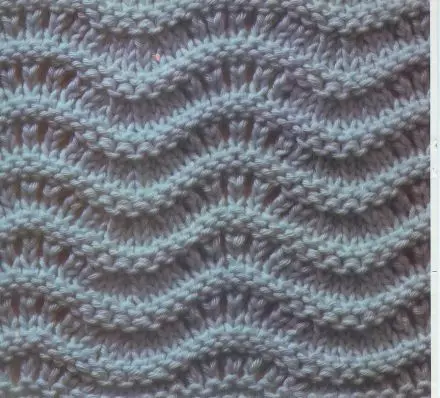
Most wavy patterns differ only in the number and method of knitting rows between the "waves". Because of this, a small retreat from the schemes represented is not a reason to dissolve the product: this pattern leaves the expanse for imagination and a small error in the end can lead to the creation of a unique "wave" option.
For example, a more geometrical version of the wave is popular, in which the pattern elements are separated by vertical tracks. Rapport such a wave - 14 loops, another is added for symmetry. Two-color or multicolor "waves" looks spectacularly. There are no mandatory rules for their creation: the second and subsequent threads can be born in any rapport, the main thing is to observe the flower gamut.
Vertical option
A little harder to knit vertical "waves", which relate not to openwork patterns, but to gum. Rapport vertical "wave" - six loops and 12 rows. The first and third row starts with three wrong. Behind them follow the facial, the wrong and one more facial.In the second and fourth rows, they first knit the involnery, then the facial, involne and three more facial loops. A wave pattern begins to form in the fifth row. For this, three loops (facial, involne and second facial) should be transferred to the right (through three irons). Then the knitting continues in the following order: on one facial, invalid and facial, and then three irons.
Knitting this row is described in detail in this video:
Rows 6, 8 and 10 knit equally. They should be started with the face loop, then follow the wrong, facial and three irons. Also, 7 and 9 rows are equally fit: three facial, and then alternation of invalid and facial.
The range 11 is similar to the fifth: three loops (facial, involne and facial) are transferred to the left through three irons. After that, you need to tie three wrong and alternation of facial and invalid. The latter in Rapporta 12 row coincides with the second.
Article on the topic: Bead flowers for beginners: Weaving schemes simple roses with video tutorials
Fantasy "Waves"
There are many descriptions of patterns created on the basis of a classic wave, which relate to the category of fantasy. They may include many elements: geometric parts, lace, combination of dense and openwork knitting, "Christmas trees", alternation of volumetric relief and smooth canvase and much more. Some of them are suitable for both direct and circular knitting.
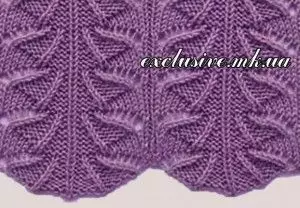
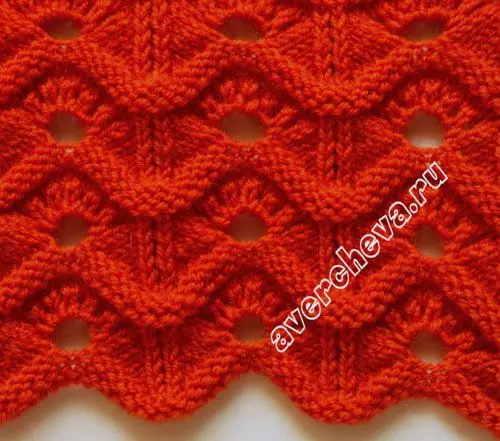
Fantasy "waves" are more difficult in performance and require more attention, in particular, you need to follow the inclination of the loops, but the result will justify such efforts. Among the fantasy patterns of medium difficulty are embossed "waves", the ranks between which are connected by vertical openwork inserts.
The rapport of such a pattern is 11 loops (one more needed for symmetry) and ten rows. The first row, as well as the third, sixth, eighth and tenth knit with completely invincible loops, and the second and fourth - facial.
The fifth, seventh and ninth rows fit in the same way. First of all, one facial loop is pronounced, then they make a nakid and knit three more facial. The following two loops are tied together with one facial, the slope is right. Then one loop is removed as the facial, after knit one facial and stretch it through the removed loop. The rapport is completed with three facial loops, nakid and another facial.
In the case of circular knitting of this pattern, its scheme is slightly different. The first four rows knit full hinges, the sixth, eighth and tenth-facial. The fifth, seventh and ninth rows should be knitted in the same way as in direct knitting waves.
